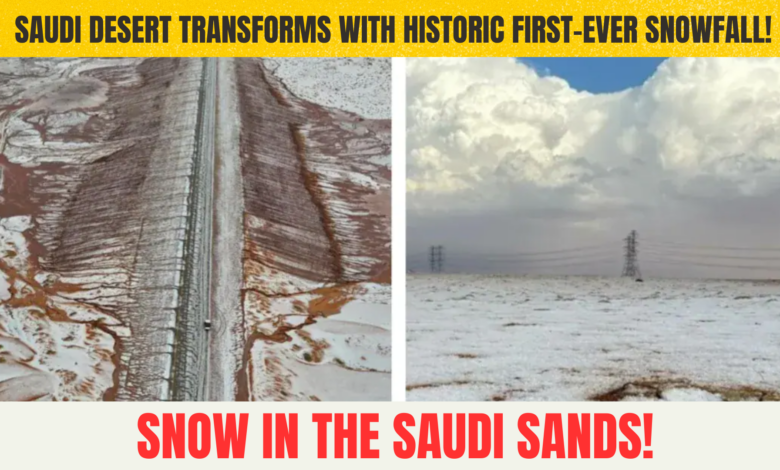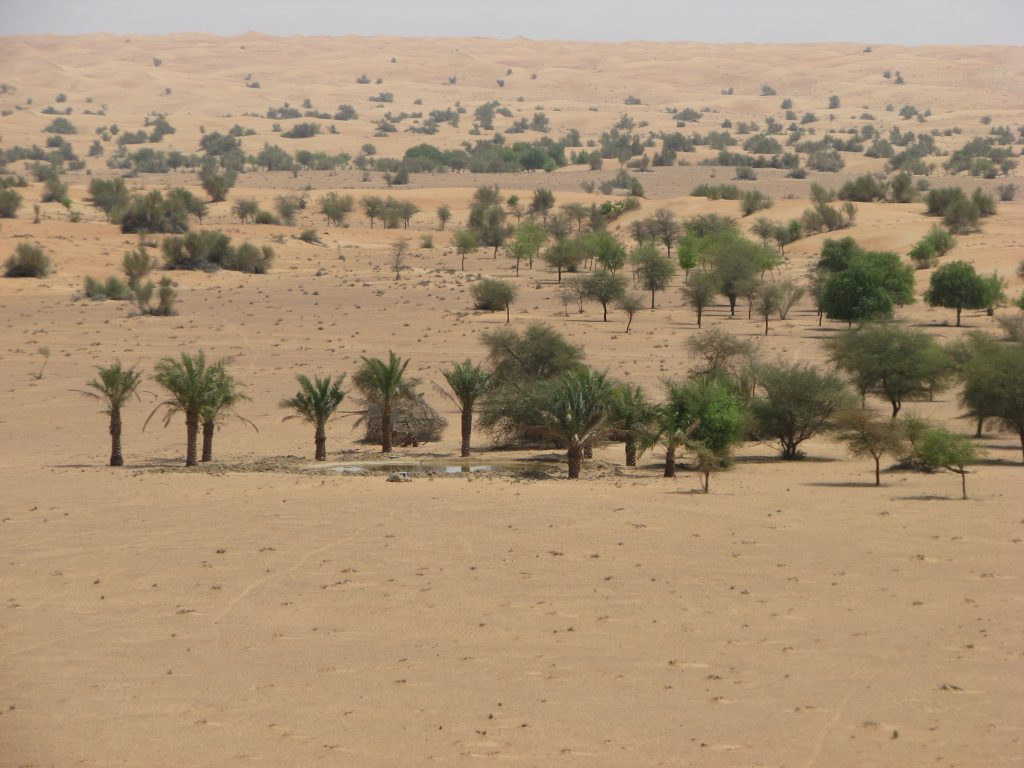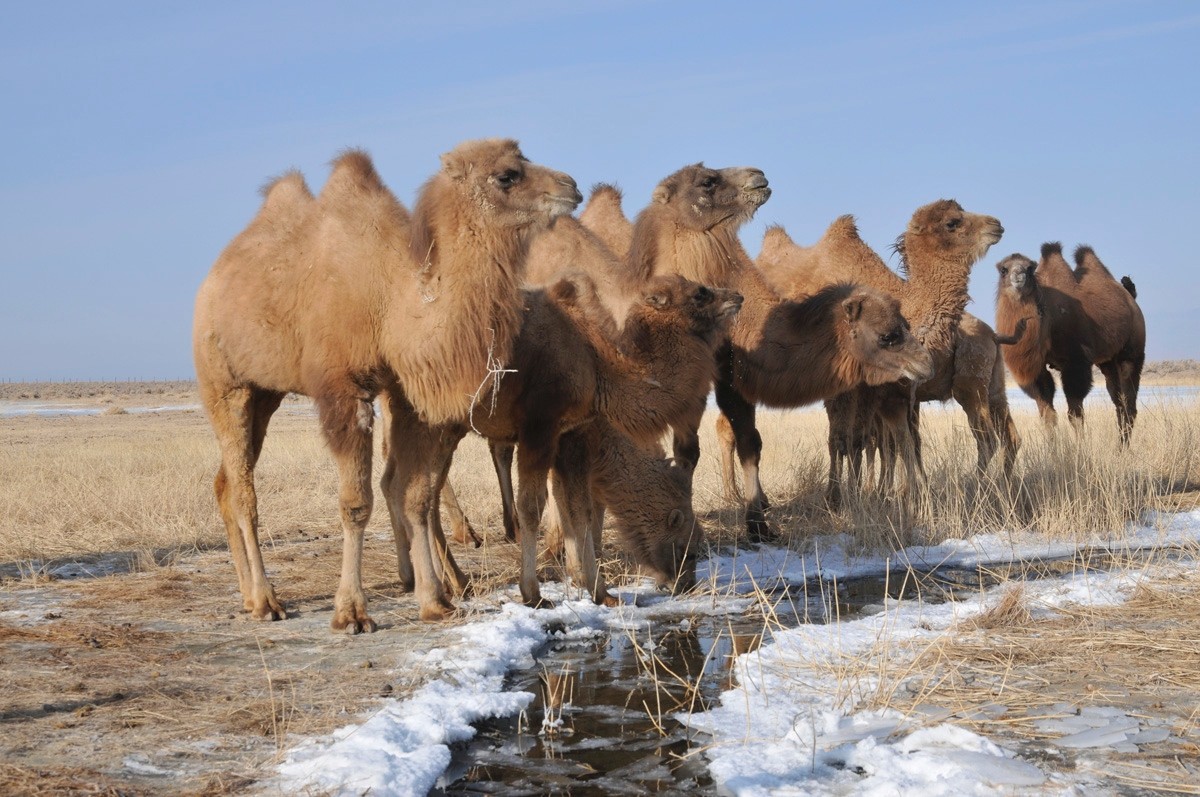Snow In The Sands: Saudi Desert Transforms With Historic First-Ever Snowfall!
Saudi Arabia's desert experiences historic snow fall for the first time, captivating global audiences and showcasing the region's changing climate and tourism potential.

In a stunning and rare turn of events, the vast sands of Saudi Arabia’s desert went from a hot desert to a winter wonderland as snow fell for the first time in history. Locals and tourists rushed to capture the unique sight of pristine white snow blanketing the iconic dunes. The region is known to be a desert that receives scorching heat. Still, it has experienced a temperature shift to freezing that has captured the world’s willingness to read along as it adds a new chapter to its climate narrative. It’s a reminder of how nature can change on the swing of a weather pattern, even moulding what appears to be the driest of environments.

Snowfall in the Arabian Peninsula is exceedingly rare, and in its desert regions — defined by intense heat and dryness — it is scarce indeed. Mountain areas such as Jabal al-Lawz occasionally receives snow, but the vast desert plains, capable of topping fifty degrees in the summer, are a third of the way from regions that signal wintery conditions.
The recent snowfall has been unprecedented, the first in modern history that snow has blanketed the Saudi desert sands. What makes the phenomenon such a challenge to our understanding of desert climates is that this is part of a more significant phenomenon that not only calls into question our ideas of what a desert climate should look like but features an aberrant weather pattern that global climate aberrations have exacerbated.
The mountainous regions of Saudi Arabia, including Jabal al-Lawz to the northwest, close to the border with Jordan, have occasionally taken snow during remarkable winter conditions. But because these higher elevations reach over 2,500 meters, they’re more susceptible to colder temperatures, particularly during seasonal cold fronts. Hence, you get brief episodes of snow every few years.

Other times, Jabal al-Lawz and the isolated Asir Mountains in the southwest get light snow or frost, which has become familiar to locals. Snow falling across open desert plains is rare but stands out starkly compared to these mountain events.
Desert flows are extremely hot during the day, creating an inhospitable ecosystem and unfavourable conditions for snow. The recent snowfall in the desert, though temporary, is unusual and striking. It highlights how changing weather patterns can lead to snowfall in one of Earth’s hottest and driest places.
Unusual Cold Fronts and Atmospheric Shifts: How Rare Conditions Brought Snow to Saudi Arabia’s Deserts
An unusual pairing of cold fronts heading south from Europe and the Northern Hemisphere, even reaching as far down as the Arabian Peninsula, appears to have been the primary cause of the snowfall in Saudi Arabia’s desert regions. Here, in normally dry, hot areas, we have a powerful cold air mass with high atmospheric moisture — the recipe for snow. In winter, temperatures in the Middle East can reach 0 degrees, often with rain. However, a cold front recently caused temperatures to drop below freezing, resulting in snow.
A low-pressure system in the upper atmosphere contributed to greater instability by introducing colder air that stayed longer than typical, raising the chances of snowfall. It is unusual to see snowflakes landing on the desert sands of Saudi Arabia, and this rare phenomenon has led to below-average temperatures, increased humidity, and extensive cold air exposure.

Droughts, floods, and wildfires, driven by global climate changes, are unprecedentedly impacting weather patterns in the Middle East. Traditionally known for extreme heat and aridity, the region is now facing unexpected fluctuations in temperature and rainfall.
More frequent and intense heatwaves are one effect of the rising global temperatures, as well as changes in weather systems in ways that can create colder-than-usual winters or unusually timed rains, among other things. But this disruption to standard climate patterns means cold fronts and unusual weather: Ancient snow in Saudi Arabia’s desert regions, a new disease outbreak in Brazil, Bangladesh’s worst flooding in 60 years, and earthquakes in Pakistan and China.
It is also experiencing an uptick in the frequency of storms, droughts, and unstable weather, which can affect daily life and injure agriculture, water resources, and the overall stability of the ecosystem. These anomalies are a real sign of how far-reaching the effects of climate change are—you even see them in the traditionally hot and arid Middle East in the form of irregular weather events.
Saudi Desert Transformed by Snow: Social Media Captures Rare Winter Wonder in Al-Jawf
The stately dunes of Saudi Arabia’s desert regions have been turned into a winter wonderland by recent snowfall, photo opportunities of which have turned heads inside and outside the country. Al-Jawf’s hilly areas are covered in snow, and a dramatic winter landscape is emerging on the ordinarily scorching desert plains, not usually seen as a feature of the Middle East.

The snow-covered Al-Jawf has caught everyone’s eye, with pictures circulating the globe and videos of it being shared across the net, telling the world that Saudi Arabia looks much colder than it has previously been. Apart from the snow, the recent intense rains have brought life back into the valleys, with waterfalls and fresh winter openings in the spring.
The rainfall has also brought natural beauty to Al-Jawf province, now renowned for seasonal wildflowers, including lavender and chrysanthemum, appealing to visitors. The weather, however, is expected to be choppy with possible thunderstorms in the coming days as the Saudi weather agency warns of expected strong winds, heavy rain and hail that can lower visibility and lead to disruptions. This unusual weather setting further enhances the charm and unpredictability of this region, which presents it to nature enthusiasts and adventure as a great place to visit.

It snowed in Saudi Arabia’s desert regions, and because social media and local news channels jumped in, this exciting event soon became a viral sensation. Amazed by the rare sight, residents shared images and videos of snow-covered dunes that snow quickly gained traction online.
The stunning visuals generated excitement among Saudis and astonished viewers globally, including those from colder climates. This was no ordinary winter; it was an extraordinary winter experience in a hot desert that challenged typical perceptions. The spread of these images fuelled global interest in this phenomenon, making it a trending topic and showcasing the beauty of Saudi Arabia’s changing climate to a broader audience.
Impact of Snowfall on Desert Ecosystems: Cold and Moisture Challenge Saudi Arabia’s Flora and Fauna
Unexpected snowfall followed by rainfall in Saudi Arabia’s deserts could significantly affect local plant and animal life adapted to extreme heat and dryness. Drought-resistant shrubs and cacti have deep roots and a waxy surface that help them survive in these harsh conditions.
But the unexpected cold and moisture could disrupt their natural cycles. For example, many desert species are dormant during the low season temperatures, and the cold rush might prevent their photosynthesis and growth. On the other hand, some plants that are not necessarily designed to cope with freezing conditions tend to suffer damage to their tissues and thus cannot survive in the short term.

Desert animals such as reptiles and insects, which depend on warmth to stimulate the body’s temperature, could find it difficult to acclimate to the sudden cold. In particular, cold-blooded creatures could slow down metabolism and lose some or all of their mobility, while some may be exposed to an increased risk of hypothermia or dehydration as they see their environment change more quickly.
Desert animals such as reptiles and insects, which depend on warmth to stimulate the body’s temperature, could find it difficult to acclimate to the sudden cold. In particular, cold-blooded creatures could slow down metabolism and lose some or all of their mobility, while some may be exposed to an increased risk of hypothermia or dehydration as they see their environment change more quickly.
Local Authorities and Residents Respond to Unprecedented Snowfall: Ensuring Safety and Embracing the Desert’s Rare Transformation
Outbreak of cold weather and the snow fall in Saudi Arabia has not taken authorities and residents by surprise and they have quickly responded by taking various measures aimed at addressing safety and infrastructure challenges. A resident of Al-Jawf, a man who both repeats the awe building up, but also adds the feeling of fear: “This is a once in a lifetime thing for us.” “Temperatures like that are not the norm for us, and it’s vital that we continue to be prepared for the cold and what it could do to our roads.”
Such icy conditions could cause accidents in mountainous and desert areas, so Saudi Civil Defence and local authorities issued advisories for road safety. Drivers were told to take care and avoid travel if possible, as they expected strong winds and hail to disrupt the snowfall. Emergency teams were also ready to assist with road clearance and medical emergencies, according to authorities.

Another tourist also said he was in awe when he saw the snow in the desert, saying, “I never imagined that I would see snow in the desert. Retro and beautiful; a little surreal as well.” Local businesses and accommodations were fast to adapt, too, with extra blankets and a supply of heat to keep lads and ladies inside comfortable. Although cold, the event became famous as a unique chance to discover something about the desert that you seldom see, increasing attraction and tourism to the area.
Snow in the Saudi Desert: A Sign of Changing Climate and a Boost for Tourism
Snowfall in Saudi Arabia’s desert regions underscores the unpredictable nature of global weather patterns, increasingly linked to climate change. Solomon noted that global warming is making weather systems more erratic, resulting in unusual events that challenge traditional views of the Middle East as solely hot and dry.
But this anomaly serves as another reminder of the fundamental importance of coming to a clear understanding of the bigger picture around climate change — as extreme weather events become more common and severe. From a tourism point of view, the snowfall in the desert could add a big bonus for Saudi to become a tourism destination, which will attract tourists who want to see this rare phenomenon. It was a refreshing counterpoint to the conventional images of the Middle East. It served Saudi Arabia as a place of natural surprises that could not be expected.
The event will also help increase the local economy by boosting tourism, increasing demand for services, accommodations and infrastructure. However, the long-term effect on the region’s natural resources and ecosystems could be disturbing as weather patterns would disturb the delicate medley of natural order in the desert. However, this event will reshape how people around the world see Saudi Arabia as Saudi Arabia will be presented with diverse landscapes and will encourage people to visit Saudi Arabia to discover its nature and culture!





